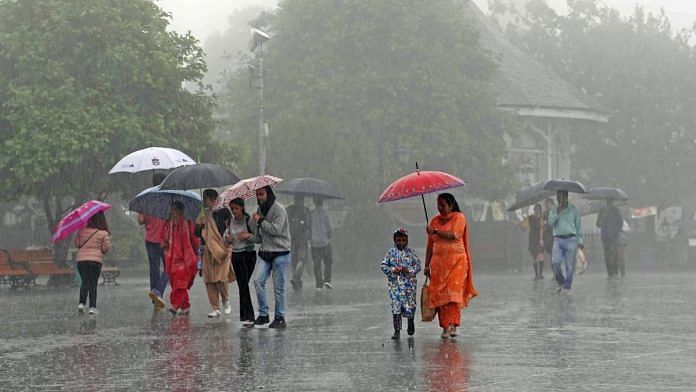New Delhi: The southwest monsoon, which brings four months of annual rainfall to India, was delayed by seven days in its arrival to the Kerala coast, raising the alarm for a bad monsoon.
However, as of 27 June, the monsoon has sped its way through Maharashtra, and even advanced to most parts in the Arabian sea, along with some parts of Gujarat and Rajasthan.
This is an indication that the week-long monsoon delay in no way impacted the overall monsoon performance. The monsoon has, so far, covered 80 per cent of the country, said Naresh Kumar, senior scientist at India Meteorological Department (IMD) in an interview with NDTV Monday.
The next two days might see the monsoon traverse into northern parts of Rajasthan, and some parts of Punjab and Haryana.
In India, the monsoon is a critical foundation to India’s economy. According to a book titled Integrated Assessment of Scale Impacts of Watershed Intervention (2018), about 70 per cent of India’s population is dependent on rainfed agriculture. It also brings relief from heat stress and summer conditions.
So why was it delayed and how did it successfully play catch up so fast? ThePrint explains.
Also read: Monsoon to be normal this year, says IMD, but warns of less rains & higher temperatures in June
Delay in hitting Kerala
After the Andaman and Nicobar Islands, it is Kerala which receives bountiful showers as the South West monsoon’s Arabian Sea Branch hits the state and India’s Western Ghats.
This is typically expected around 1 June. However, this year, it entered the state on 8 June, the same time as it had entered the state back in 2019. The delay this year was caused due to the formation of severe cyclonic storm Biparjoy in the Arabian Sea.
According to reports, the southwest monsoon arrived in Kerala on 29 May in 2022, 3 June in 2021, 1 June in 2020, 8 June in 2019 and 29 May in 2018.
The monsoon then moves towards the north, based on atmospheric conditions and the development of low-pressure areas, which may affect the regular arrival dates on which the monsoon is expected to hit different parts of the country. However, its entry into Kerala does not determine how it will impact the rest of the country.
A speedy advancement
This year, despite the delay in onset, there has been a speedy advancement of the monsoon to various parts of the country because of the low-pressure area created in the Bay of Bengal Sunday, said Kumar. This strengthened the impact of the monsoon showers.
Having advanced in maximum parts of India, the IMD Monday even issued an alert for heavy rainfall in most parts of the country.
On 26 June, the IMD even issued a fisherman warning for the next five days in the states of Kerala, Karnataka, Maharashtra, southern parts of Gujarat. Rainfall and thundershowers were also observed over Sikkim, West Bengal, Odisha, Jharkhand, Himachal Pradesh, Kashmir and Ladakh over the past two days.
While the monsoon has already covered much of North India, including Himachal Pradesh, Uttarakhand, and a large part of Jammu and Kashmir, ahead of schedule on 25 June, it is running two weeks behind schedule for a considerable part of central India, where a significant number of farmers heavily rely on it.
Even though central India is expected to see moderate rainfall over the next couple days, the IMD predicts heavy rainfall in Chhattisgarh and Madhya Pradesh due to a low pressure area which has now been created in the region.
On 25 June, the monsoon hit Delhi and Mumbai simultaneously — something that has not happened in six decades. On average, the monsoon onset in Mumbai is expected much earlier, by 11 June, than in Delhi, around 27 June. Thus, while the monsoon was very late to hit Mumbai, Delhi saw rain showers slightly earlier.
“It is the first time since 21 June, 1961, that the monsoon arrived in Delhi and Mumbai at the same time,” said D.S. Pai, a senior scientist at the IMD.
The Safdarjung Observatory, Delhi’s primary weather station, logged 48.3 mm rainfall in the 24 hours ending 8.30 am Sunday. Mumbai’s Colaba Observatory noted 86 mm rainfall during the same time frame.
Pai further explained that Cyclone Biparjoy impacted the monsoon’s progress over southern India and the adjoining western and central parts of the country.
“Since the system absorbed most of the moisture, the monsoon’s progress along the west coast was slow,” he told PTI.
The El Niño factor
Another factor to be kept in mind is El Niño.
El Niño is a weather phenomenon that creates an abnormal warming of the Pacific Ocean near South America, and has been known to negatively affect monsoons in India, by creating warm weather over the Indian subcontinent.
It induces changes due to natural interactions between the ocean and atmosphere, and causes severe drought in Southeast Asia, India and Australia.
The IMD had previously predicted that India would see ‘normal’ monsoon conditions this year, despite the effects of El Niño. This means that the total rainfall all over the country should be within normal limits, but there might be some discrepancies between different regions.
(Edited by Zinnia Ray Chaudhuri)
Also read: IMD forecasts ‘slight but not significant delay’ in arrival of Southwest Monsoon this year



